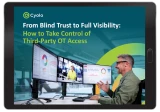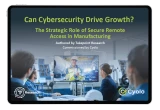Table of Contents
Recent years have seen industrial enterprises push toward ever greater levels of digitalization, automation, and remote connectivity. But with this greater connectivity comes greater complexity – and greater risk.
Which brings us to a key realization that too often goes unsaid: you’ll never be able to achieve 100% security. It’s simply impossible to sustainably enforce the highest levels of security control over every single user, device, and asset.
So, in light of limited resources, doesn’t it make sense to focus on the access scenarios that have the biggest impact on your organization's overall security posture?
Enter privileged access – arguably the single most important access layer to secure when protecting cyber-physical systems (CPS) and operational technology (OT) environments from internal and external threats.
For leaders responsible for OT security, safeguarding instances of privileged access is one of the smartest, highest-ROI moves you can make.
Let’s explore why.
What is Privileged Access? (And Who is a Privileged User?)
In the world of information technology (IT), ‘privileged access’ typically refers to administrator-level permissions – those golden keys that unlock entire systems. But in OT, privileged access has a much wider meaning.
Cyolo defines privileged access as:
Any user access that, if misused or compromised, could cause catastrophic damage to the company.
Who needs privileged access will vary from organization to organization, but examples of privileged users often include:
Third-party contractors accessing Supervisory Control and Data Acquisition (SCADA) and other highly sensitive systems
Original equipment manufacturers (OEMs) performing remote diagnostics
Remote employees overseeing industrial control systems (ICS)
On-prem operators interacting with critical assets, such as programmable logic controllers (PLCs) or human-machine interface (HMI) systems
Privileged users generally make up a small portion of an organization’s workforce, perhaps around 10%. However, a single misstep or stolen credential can halt production, damage equipment, violate safety protocols, or even endanger lives.
Why Privileged Access Demands Top Priority in OT
You can’t eliminate every cybersecurity threat. But you can dramatically reduce your exposure by focusing on where the most risk lives: with privileged users.
These high-risk accounts hold the keys to your most critical systems, making them a top target for threat actors. Here’s why:
They’re valuable – privileged access leads straight to critical systems and sensitive data.
They’re visible – attackers actively seek out these accounts through phishing and social engineering.
They’re often unmanaged – third-party vendors and contractors may connect via their own devices with limited oversight.
And the potential consequences of privileged access falling into the wrong hands?
Financial damage – from operational downtime, lost goods, and breach remediation.
Reputational damage – through lost trust with clients and regulators.
Human safety risk – due to the disruption of cyber-physical systems.
Business continuity risk – in the worst case, a privileged access breach can shutter operations.
It’s no wonder then that analyst firm Gartner predicts “by 2026, organizations applying least privilege principle approaches to remote privileged access management (RPAM) use cases will reduce their risk exposure by more than 50%.”1
Securing just a small group of high-risk users can lead to a significant – and fast – reduction in risk.
The Problem: Traditional Secure Remote Access Tools Aren’t Enough
Many security leaders still rely on legacy secure remote access (SRA) methods like VPNs, jump servers or basic remote support software.
But these methods weren’t built for the realities of OT. They often:
Assume 24/7 cloud connectivity, which is not always viable in industrial environments
Lack support for essential legacy systems
Require downtime for updates, which is incompatible with 24/7 uptime requirements
Provide overly broad network access, with limited visibility, oversight, or control
Instead of mitigating risk in the OT environment, traditional SRA tools can unintentionally increase it – especially when used to secure privileged access scenarios.
The Solution: Remote Privileged Access
Remote Privileged Access Management (RPAM) is a new category of tools purpose-built to secure privileged users in any industry or environment.
Unlike most legacy SRA products, RPAM manages the entire session lifecycle of remote privileged access – from authentication and authorization to termination and audit.
Key RPAM capabilities include:
Session brokering to prevent direct network access
Credential injection so passwords are never seen or shared
Just-in-time access with zero standing privileges
Granular controls over user activity, including clipboard usage and file transfer
Audit logging and session recording for compliance
Identity lifecycle management for remote and third-party access
VPN-less access that works across on-prem, cloud, and offline systems
The ideal RPAM solution will be designed to work with legacy infrastructure and complex, partially connected architectures – both common in OT and cyber-physical environments.
Why Focus on Privileged Access First?
Securing privileged access is one of the most effective and least disruptive cybersecurity investments OT leaders can make.
High impact – secure the users who pose the greatest risk to your most critical systems and assets.
Low friction – deploy granular controls with minimal effort and no downtime.
Fast ROI - dramatically reduce organizational risk without costly and disruptive overhauls.
Easy to scale – start small, prove value, then scale to your wider business.
In short, RPAM makes privileged remote access fast and seamless – for external vendors, internal users, and your security team.
Start by Securing the Most Critical Connections
Every connection in your OT environment carries risk. But privileged access? That’s where the stakes are highest – and the payoff is greatest.
Securing privileged users isn’t just smart cybersecurity. It’s the foundation for enabling the safe, scalable remote access that will keep your business driving toward the future.
So start with your highest-risk privileged users. Gain visibility and control over their connections. And then, once your most vulnerable access points are secured, you can choose whether to expand controls to lower-risk users.
Ready to find a new remote access tool that includes RPAM capabilities? Download the Manufacturers' Guide to Secure Remote Access for OT and get the clarity and confidence you need to future-proof access to your OT and cyber-physical systems.
1 Gartner, Securing Remote Privileged Access Management Through RPAM Tools, Abhyuday Data, Felix Gaehtgens, Michael Kelley, 28 December 2023.
GARTNER is a registered trademark and service mark of Gartner, Inc. and/or its affiliates in the U.S. and internationally and is used herein with permission. All rights reserved.

Shir Basok
Author
Shir Basok is a Product Marketing Manager at Cyolo, where she transforms deep technical expertise in secure remote access and OT security into stories that drive awareness and action. She’s passionate about simplifying cybersecurity and helping organizations protect what matters most — their operations.

Subscribe to Our Newsletter







